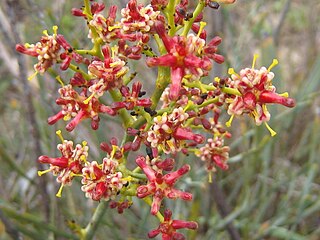
Stirlingia latifolia, commonly known as blueboy, is a plant endemic to Western Australia.
Chthonocephalus is a genus of annual herbs in the family Asteraceae. The genus is endemic to Australia, with species occurring in all mainland states.

Actinobole is a genus of dwarf annual herbs in the family Asteraceae described as a genus in 1843.
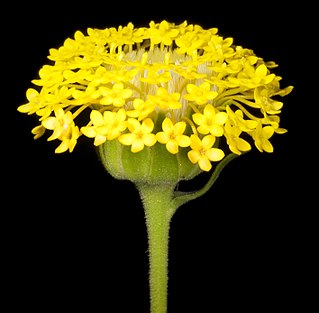
Podotheca is a genus of flowering plants in the pussy's-toes tribe (Gnaphalieae) within the Asteraceae. All species are endemic to Western Australia, except for Podotheca angustifolia which occurs across the south of Australia.

Asteridea is a genus of flowering plants in the family Asteraceae. Evidence suggests that the genus, Asteridea, is monophyletic.

Dicrastylis is a genus of plants in the Lamiaceae, first described in 1855. The entire genus is endemic to Australia. The type species is Dicrastylis fulva.
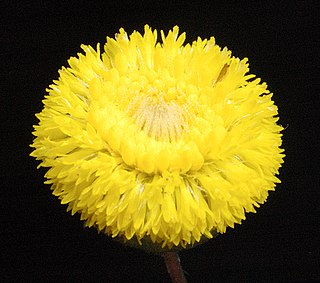
Panaetia, a genus in the Asteraceae (daisy) family, was first described by Henri Cassini in 1829 It is considered by Plants of the World online and the Global Compositae Database to be a synonym of Podolepis Labil,. while GBIF states it as "doubtful". However, in 2021, the Western Australian Herbarium accepted Jeffery Jeanes new circumscription of the genus, together with two species of Panaetia as being found in Western Australia: Panaetia lessonii, and Panaetia tepperi. Jeanes distinguished Panaetia from the genera, Podolepis, Siemssenia and Walshia, using the following characters:
- the outer florets are all tubular; and
- the cypselas are minutely tuberculate and lack long finger-like papillae.

Podolepis canescens is a herb in the Asteraceae family, which is found in South Australia, the Northern Territory, New South Wales and Victoria. PlantNet also states that it is found in Western Australia, but FloraBase states that the name is misapplied in Western Australia, based on Jeanes (2015).
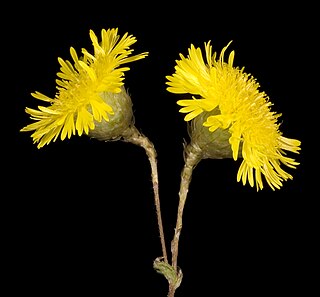
Podolepis aristata is a herb in the Asteraceae family, which is found in Western Australia, and all mainland states and territories of Australia.

Asteridea pulverulenta is a species of flowering plant in the Asteraceae family, which is endemic to Western Australia, in the south-west. It was first described in 1839 by John Lindley.

Asteridea chaetopoda is a species of herb in the Asteraceae family, which is endemic to Western Australia, in the south-west. It was first described in 1876 as Athrixia chaetopoda by Ferdinand von Mueller, and allocated to the genus, Asteridea, in 1980 by G. Kroner. It is a perennial herb, growing on sandy soils, on limestone and on gypsum, to heights from 5 cm to 30 cm. Its yellow flowers may seen from August to November on salt lakes, stony rises, and dunes of Beard's Eremaean and South-West Provinces.
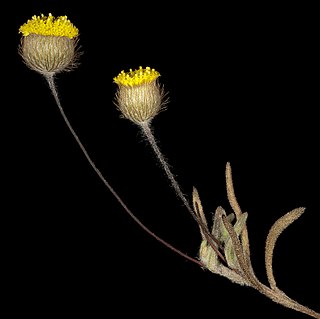
Asteridea athrixioides is a herb in the Asteraceae family, which is endemic to Australia, and found in Western Australia, South Australia and Victoria. It was first described in 1853 by Otto Sonder and Ferdinand von Mueller as Panaetia athrixioides, who described it from specimen(s) collected in the Port Lincoln district. In 1980, G. Kroner assigned it to the genus, Asteridea, giving it the name Asteridea athrixioides. It is an annual herb, growing on calcareous, sandy or clay soils to heights of from 5 cm to 20 cm. Its yellow flowers may seen from July to November on saline on allvial flats, rocky hills and undulating plains.
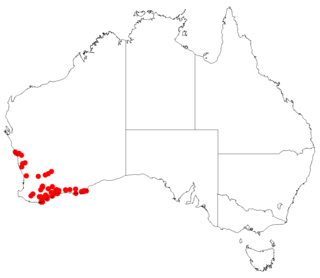
Asteridea asteroides is a herb in the Asteraceae family, which is endemic to Western Australia. It was first described in 1853 by Nikolai Turczaninow as Trichostegia asteroides. In 1980, G. Kroner assigned it to the genus, Asteridea, giving it the name Asteridea asteroides. It is a perennial herb, growing on sand or gravelly sand to heights of from 5 cm to 30 cm. Its white flowers may seen from August to November in Beard's South-West Province.

Asteridea morawana is a herb in the Asteraceae family, which is endemic to Western Australia. It was first described in 2000 by Philip Short.
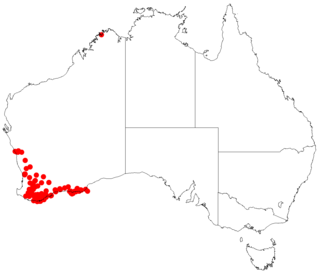
Asteridea nivea is a herb in the Asteraceae family, which is endemic to Western Australia. It was first described in 1845 by Joachim Steetz as Chrysodiscus niveus. In 1980, G. Kroner assigned it to the genus, Asteridea, giving it the name Asteridea nivea. It is a perennial herb, sometimes erect, sometimes low-spreading which grows on sandy soils often over granite, laterite, or limestone to heights from 10 cm to 60 cm, in rock crevices, on ridges and coastal cliffs. Its white to white-pink flowers may seen from April to May or August to September in Beard's South-West Province, that is, the IBRA regions of Avon Wheatbelt, Esperance Plains, Geraldton Sandplains, Jarrah Forest, Mallee, and Warren.
Asteridea croniniana is a herb in the Asteraceae family, which is endemic to Western Australia. It is an annual herb, growing to a height of 8 cm.

Dicrastylis archeri is a species of plant within the genus, Dicrastylis, in the family Lamiaceae. It is endemic to the south-west of Western Australia.

Blennospora phlegmatocarpa is a herb species in the family Asteraceae. It is found in Western Australia.

Pembertonia latisquamea is a species of daisy (Asteraceae), native to Western Australia. It was first described by Ferdinand von Mueller in 1878 as Brachyscome latisquamea and transferred to the genus, Pembertonia in 2004 by Philip Short.

Pterochaeta is a monotypic plant genus in the Asteraceae family, endemic to Western Australia. It was first described in 1845 by Joachim Steetz and its only species is Pterochaeta paniculata.

















